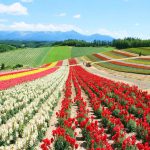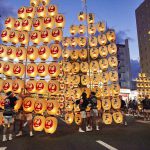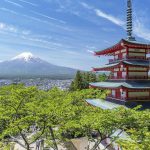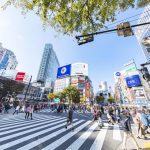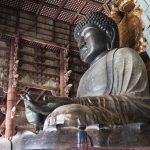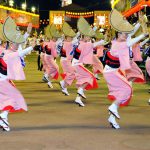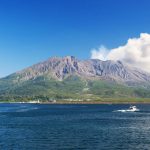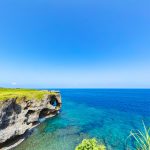Kansai
This region is also known as Kinki, and is located slightly west of the center of Japan. Since it was the birthplace of the ancient nation of Japan, and Kyoto served as the capital until the Meiji Restoration, it emerged as the center of politics, economy, and culture. As a result, it is a very popular travel destination, with many historically significant buildings, sites, and traditional crafts. There is easy access to the Kansai region for those traveling both locally and abroad by way of shinkansen (bullet train), highway buses, as well as Osaka (Itami) Airport and Kansai International Airport.
The Kansai region consists of Osaka, Kyoto, Mie, Shiga, Nara, Wakayama, and Hyogo prefectures. Following are introductions of these prefectures, with the exception of Kyoto and Nara.
Mie
Ise Jingu Shrine in Ise, Mie Prefecture, is the collective name for 125 Shinto shrines, including Geku (Outer Shrine) and Naiku (Inner Shrine), and is the most highly revered of the shrines in Japan. Worship begins from Geku to Naiku, and each of the shrines is visited in the order of Goshogu and Betsugu, respectively. There is also a special form of worship, called mikakiuchi, which brings you closer to the gods than usually allowed. Geku enshrines Toyouke-no-Okami, the guardian deity of all industries such as food, clothing, and shelter; and Naiku enshrines Amaterasu-Omikami (goddess of the sun), the highest of the deities.
The Inner and Outer Shrines and the 14 outlying shrines are rebuilt every 20 years, and the enshrined deities are relocated. It is a Shinto ritual that has continued for about 1,300 years since 690, with the next one taking place in 2033. At the Sengukan Museum, located in the Outer Shrine, you can see a full-scale, partial reproduction of the main hall, and learn about the ancient Japanese architectural style and craft techniques.
Oharaimachi is the town located in front of the torii gate of the Inner Shrine, and is lined with souvenir shops and restaurants. Okage Yokocho, located in Oharaimachi, recreates the old streets of the Edo period, making it a very popular destination.
Ago Bay on the Shima Peninsula offers a beautiful natural landscape of intricate coastal inlets and numerous islands. It is also known as a pearl cultivation area, and the rafts of pearls floating in the quiet sea create a beautiful scene. It is recommended for its spectacular panoramic view of Ago Bay from both Yokoyama and Tomoyama observatories.
Shiga
Enryakuji Temple, which is registered as a World Heritage Site, is the main temple of the Tendai sect of Buddhism in Japan, which spans the entire area of Mt. Hiei at an altitude of 848 meters, and straddles Shiga and Kyoto prefectures. It was built by Saicho in 806. During the Heian period, it claimed the highest position in Heian Buddhism, along with Koyasan Kongobuji Temple, which was founded by Kobo Daishi (also known as Kukai), and has gained tremendous power with the support of the imperial family and aristocrats. In the east tower area of Enryakuji Temple, there is a sacred and solemn atmosphere with the Konpon Chudo Hall and its immortal lamp, which has been lit continuously for more than 1,200 years; the east tower of Hokke Somochi-in; and the Monju-rou, the main gate of Mt. Hiei. It is accessible from Kyoto by public transportation such as bus, cable car, and aerial tram.
Lake Biwa, the largest lake in Japan, has a beautiful natural landscape registered under the Ramsar Convention, and is dotted with historically important sites, temples, and shrines. The main attractions include Sakamoto-Monzenmachi, a town that flourished on the surrounding perimeters of Enryakuji Temple, and is home to historical buildings that display their unique stone masonry; Miidera Temple (formally Onjoji) with its Kondo (main hall), classified as a national treasure; Ishiyamadera Temple, a famous place for cherry blossoms and autumn foliage; Saimyoji Temple, a national treasure; Kongorinji Temple; and Chikubu Island, home to Tsukubusuma Shrine, a popular spiritual energy spot. Hikone Castle, located on the east side of the lake, was completed in 1622. It is one of the few castles with a tower that has been designated as a national treasure, and also features a beautiful white wall.
Hyogo
Hyogo Prefecture, which stretches far north to south, facing the Seto Inland Sea and the Sea of Japan, is abundant with natural resources. Kobe is a port town with a foreign flair that has prospered in trade since ancient times. You can enjoy walking around Motomachi with its 1-km long shopping street. From the top of Mt. Rokko, you can see the beautiful night view of Kobe, which is often referred to as a “million dollar night view.”
Built in 1609, Himeji Castle is considered to be one of only 12 remaining original castle towers built before the Edo period in Japan. It is designated as a national treasure and an important cultural property, and is registered as a World Heritage Site. It is a famous castle that well represents Japan. Miraculously, the castle was not destroyed by fire during the Pacific War, and has been well preserved in its original state. The grand tower is a masterpiece of architectural technology, with turrets, stone walls, and earthen walls. The vast and complex structure makes it difficult to reach the tower, even when walking inside the castle. Not only its historical architectural value, but also the vivid and graceful beauty of its white-plastered walls is what gives Himeji Castle its undeniable charm.
Other highlights include the ruins of Takeda Castle, known to appear as a “castle in the sky, floating in a sea of clouds,” especially in the mornings from autumn to winter; Arima Onsen, which is said to be the most spiritual hot spring in the world; and Awaji Island, connected by the Akashi Kaikyo Bridge, the world’s longest suspension bridge.
Wakayama
The Kumano Kodo is the collective name for the pilgrimage trails that lead to Kumano Sanzan (three mountains), which span Wakayama, Nara, Mie and Osaka. Kumano Sanzan is comprised of three shrines, Kumano Hongu Taisha, Kumano Nachi Taisha, and Kumano Hayatama Taisha; each of which has its own origin in nature worship. Since ancient times, the Kumano Sanzan belief has grown and many, from the emperor to common people, have come to visit and pay their respects to Kumano.
Kumano Hongu Taisha Shrine, which is the center of Kumano worship, has a solemn atmosphere. The Otorii Gate, which is the largest in Japan, is truly a masterpiece. Nachi no Taki waterfall is the deity of Hiro Jinja, a branch shrine of Kumano Nachi Taisha. At Hiro Jinja, there is no main shrine or worship hall, but rather direct nature worship of the waterfall. It is believed that the drops of water released by the waterfall are beneficial for longevity. Nachi no Taki and the three-story vermillion pagoda at Seigantoji Temple complement the sacredness of this area.
Koyasan (Mt. Koya) was founded by Kobo Daishi, also known as Kukai, and is a holy place of the Shingon sect of Buddhism, with 117 temples including Kongobu-ji Temple. It is said that Kukai returned to Japan in 806, after learning about Mantra in Changan, China, the capital of the Tang Dynasty at that time, and began his efforts to establish Koyasan, which was formally founded in 816.
Koyasan has many highlights, including two major sacred sites, the Danjo Garan and Okunoin. The Danjo Garan is where Kukai opened the original dojo of Shingon Esoteric Buddhism, and includes Konponpon Daito, a 48.5-meter high pagoda, representing the world of mandalas; Kondo, the main hall of Koyasan; and Mikagedo, which is believed to be Kukai’s residence. Okunoin is the site of the mausoleum of Kobo Daishi (the name given to Kukai, posthumously), and the sacred atmosphere of the 2-km long approach is overwhelming, with more than 200,000 gravestones and cenotaphs of various people, from royalty to feudal lords, politicians, writers, businessmen, and common people, lined amidst the deep grove of cedar trees.
In Koyasan, you can stay at a shukubo, which are the accommodations of a temple; there are approximately 50 of them at Koyasan. Originally, they were intended for the use of monks and worshippers, but now there are shukubo that are available to tourists. You can enjoy the historic buildings, gardens and vegetarian cuisine, as well as experience zazen and sutra copying (hand-copying the calligraphy of Buddhist sutras).


